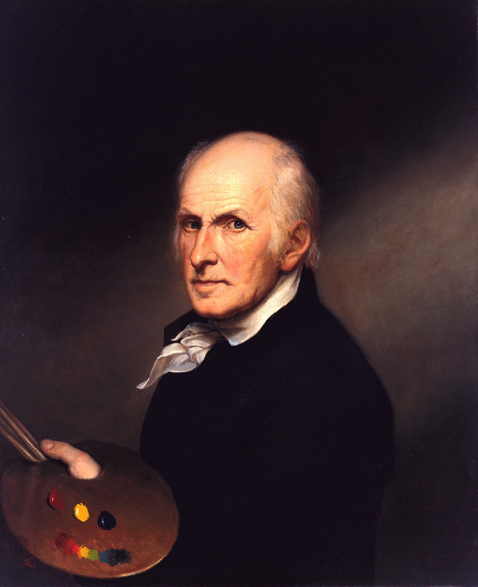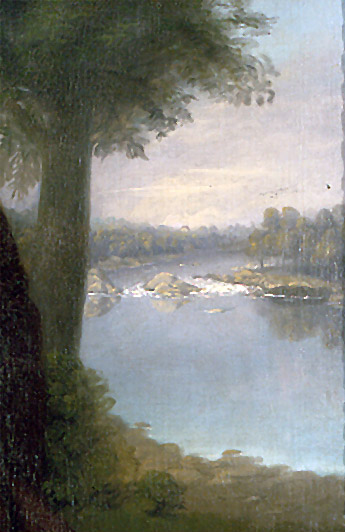An Emerging Talent
Peale’s talent was emerging. Creditors being temporarily mollified, Charles returned to Annapolis, Maryland. Portrait painting pointed to better prospects than saddle-making. John Beale Bordley, after studying a portrait Peale had sent to Bordley’s sister, came from the viewing room and announced to his sister’s family, “Something must, and shall be done for Charles,”[1]Charles Coleman Sellers, Charles Willson Peale (New York: Scribner’s, 1969), and from Edgar Richardson, Brooke Hindle, and Lillian Miller, Charles Willson Peale and His World (New York, Abrams, … Continue reading and proceeded to raise money to send him to England to study. Leaving Rachel and their young son, with high hopes for his new profession and eager to see that the inheritance promised his father (and now him as well) was secure, Peale sailed for England in December of 1766.
With letters of introduction, Peale called on fellow American Benjamin West in London.[2]Expatriate Benjamin West (1738-1820) achieved great success in England. Although he created many types of works, he is best known for his historical paintings, the most famous of which is The Death … Continue reading Idealistic, selfless, generous, successful, West was a perfect model and teacher for Peale. He worked as one of West’s assistants, painting backgrounds. Peale’s first major assignment was probably to paint a watercolor copy of West’s Elisha Restoring to Life the Shunammite’s Son.
Peale lived frugally and worked hard. In these days before the opportunities afforded by public galleries, Peale through West saw Sir Joshua Reynolds’ painting room, was admitted to the occasional art show, and studied West’s own paintings. While Peale during his lifetime was never satisfied with pursuing one project at a time or even with one career, he left London more settled and focused than when he first arrived. All hope of an English inheritance was given up, the exact reason never clear but likely having to do with his father’s early disgrace.
Peale the Painter
Peale for a time decided that his particular focus as a painter would be the miniature. Sellers calls the decision characteristic. Peale sought to avoid emulation and rivalry. West painted large historical works, so Peale, who took “pleasure in shining alone” chose miniatures “as his own particular province.”[3]Sellers, 58. But Charles Willson Peale became thoroughly imbued with West’s view of art and the artist. Frustrated by the failed inheritance, Peale could embrace a “new concept of human worth, open to every man or woman, the new nobility of virtue and talent, the aristocracy of art.”[4]Sellers, 60. As Sellers writes, “To be an artist, true to oneself and the art, was to possess a loftier dignity than any conferred by birth. Art was an allegiance without boundaries of place, the artist a citizen of the world.”[5]Sellers, 61.
Peale exhibited some miniatures in London, painted some on his return to America, and during the Revolutionary War executed a series of them depicting officers and others associated with the Colonial army, but his interest began shifting to regular-sized canvasses. One reason for shifting his interest was a commission by his friend and patron, the wealthy Edmund Jenings, to paint William Pitt, Earl of Chatham, to show appreciation for Chatham’s opposition to the Stamp Act. A huge painting, showing Chatham in ancient Roman garb, the work was overtly political, a persuasive visual statement of support for Chatham’s defense of the rights of Englishmen in America. Peale produced a print of the painting, intending to make money selling mezzotint copies, but like so many of Peale’s plans to make money, selling the Chatham mezzotint did not realize what was hoped.
Charles Willson Peale, having used his time and his patrons’ money well under West’s tutelage, with high hopes sailed back to America in March 1769.
Back in Maryland
In the background is the Schuylkill River, and the famous Schuylkill Falls which once could be heard from Philadelphia when the wind was right.
The reunion with Rachel must have indeed been touching. During their separation of two years, two infant children had died—in fact, they would lose two more by 1772. But career prospects were bright. Charles Willson set himself up as a portraitist in Annapolis. Commissions came his way. He was establishing himself, but it soon became apparent that Annapolis was too small a place for him. Peale traveled frequently, offering his services in Maryland beyond Annapolis, in Virginia, in South Carolina, and Philadelphia. During these years the friendship began with George Washington, whom Peale painted at Mount Vernon in 1772; it is the earliest known authentic image of Washington.[6]Peale to Jenings, August 29, 1775. Lillian B. Miller, Sidney Hart, and David C. Ward, eds., The Selected Papers of Charles Willson Peale and His Family, 5 vols. ([New Haven]: Yale University Press, … Continue reading
Washington, though well-known, was not yet the American icon. For Peale’s career, a painting of John Dickinson commissioned by Edmund Jenings was more important. A lawyer, Dickinson had published Letters from a Farmer in Pennsylvania, to the inhabitants of the British Colonies (1767), a well-received statement of American self-reliance and independent spirit. Dickinson introduced Peale to John Cadwalader, later a general during the Revolutionary War, whose family portrait Peale painted. Cadwalader’s and Dickinson’s prominence and access to patronage heavily influenced Peale’s decision to move to Philadelphia.
Over the next few years, while his family remained in Maryland, Peale was peripatetic, seeking commissions wherever he could find them, and working to pay his debts. One long sojourn, the winter of 1774-75, was spent in Baltimore. Finally, in August 1775 he could write Jenings in London, “I have just now worked myself out of Debt. Except my Debts of Gratitude, I owe nothing on this side [of] the Atlantic.”
Having made up his mind to relocate to Philadelphia, Peale left Maryland in mid-June of 1776 with his wife, two children, a nanny, his mother, two orphaned children then living with the Peales, and two slaves. It was typical of the large, extended assembly of family and servants that Peale maintained for the rest of his life.
Notes
| ↑1 | Charles Coleman Sellers, Charles Willson Peale (New York: Scribner’s, 1969), and from Edgar Richardson, Brooke Hindle, and Lillian Miller, Charles Willson Peale and His World (New York, Abrams, 1982). |
|---|---|
| ↑2 | Expatriate Benjamin West (1738-1820) achieved great success in England. Although he created many types of works, he is best known for his historical paintings, the most famous of which is The Death of General Wolfe, the heavily allegorical, epic painting of the death of the conqueror of French Canada during the Seven Years’ War. West obtained royal patronage and served as second president of the Royal Academy of Art. With a huge output that varied in quality, West was famous and popular but fell out of favor with artists and critics. Nevertheless, his influence in the history of art was significant. Not only Peale, but also Washington Allston, Gilbert Stuart, and John Trumbull all worked in West’s studio. |
| ↑3 | Sellers, 58. |
| ↑4 | Sellers, 60. |
| ↑5 | Sellers, 61. |
| ↑6 | Peale to Jenings, August 29, 1775. Lillian B. Miller, Sidney Hart, and David C. Ward, eds., The Selected Papers of Charles Willson Peale and His Family, 5 vols. ([New Haven]: Yale University Press, 1983-2000), vol. 1, Charles Willson Peale: Artist in Revolutionary America, 1735-1791, 142. Hereafter cited as Peale Papers. |
Experience the Lewis and Clark Trail
The Lewis and Clark Trail Experience—our sister site at lewisandclark.travel—connects the world to people and places on the Lewis and Clark Trail.
Discover More
- The Lewis and Clark Expedition: Day by Day by Gary E. Moulton (University of Nebraska Press, 2018). The story in prose, 14 May 1804–23 September 1806.
- The Lewis and Clark Journals: An American Epic of Discovery (abridged) by Gary E. Moulton (University of Nebraska Press, 2003). Selected journal excerpts, 14 May 1804–23 September 1806.
- The Lewis and Clark Journals. by Gary E. Moulton (University of Nebraska Press, 1983–2001). The complete story in 13 volumes.





